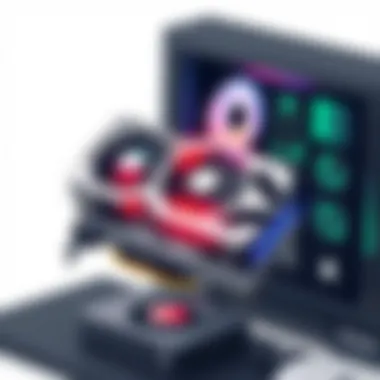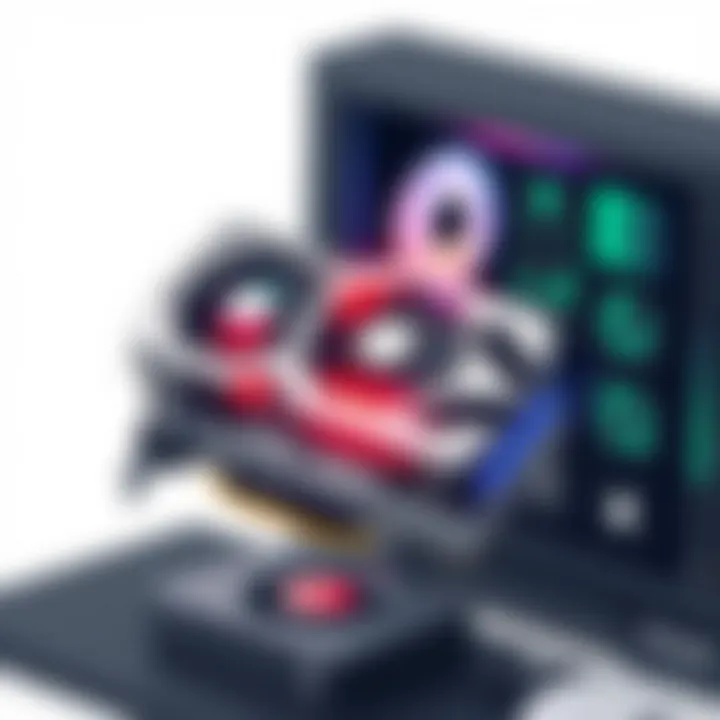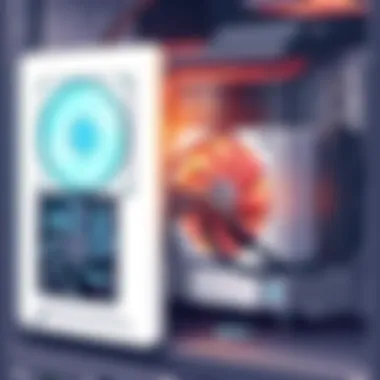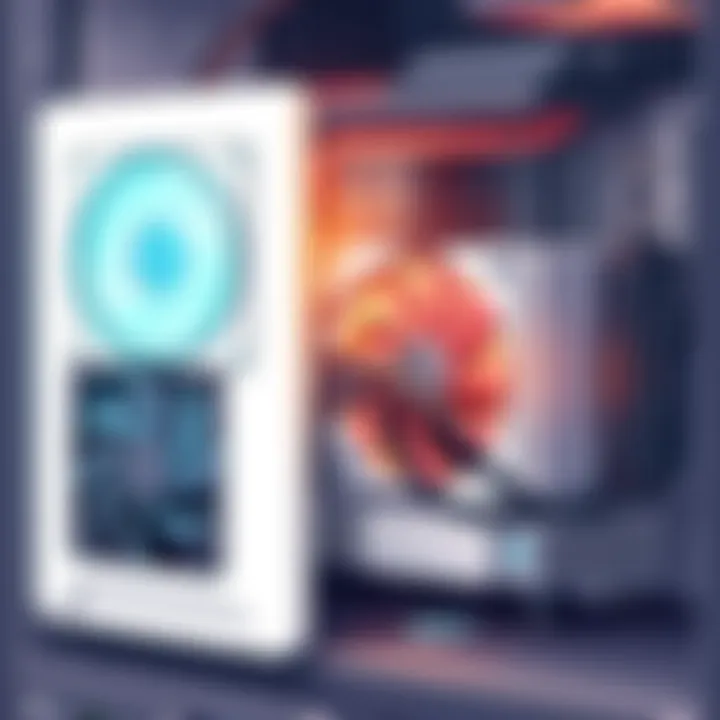Key Factors to Consider When Building a Gaming PC


Intro
Building a gaming PC is akin to crafting a finely-tuned machine, where each component plays its part in delivering an exhilarating experience. Whether you’re a casual gamer diving into immersive worlds or a competitive player racing against the clock, the choices you make in assembling your rig matter immensely. It’s not just about picking brands off a shelf; it’s about understanding how these components work together in harmony.
In this guide, we will delve into the essential elements that constitute a gaming PC, touching on aspects like performance metrics, compatibility nuances, and peripheral enhancements. This journey will provide you with insights tailored for both newbies fumbling through their first builds and seasoned tech aficionados looking to optimize their setups.
Get ready to demystify the process, ensuring you have a hand on the wheel as you steer through the intricacies of gaming hardware selection and assembly.
Product Overview
When diving into the realm of gaming PC components, it’s vital to grasp the broader picture before zooming in on the finer details. Each key component—such as the CPU, GPU, motherboard, RAM, and storage—serves a distinct function, working collectively to bring your gaming fantasies to life.
Key Components and Specifications
- CPU (Central Processing Unit): The brain of your machine. Brands like Intel and AMD offer powerful options such as the Intel Core i9 and AMD Ryzen 7, both catering to diverse gaming needs.
- GPU (Graphics Processing Unit): The heart of any gaming setup, with names like NVIDIA GeForce RTX 3080 being industry favorites for high-performance gaming.
- Motherboard: Your PC's backbone, with models from ASUS or MSI offering excellent compatibility and features depending on your desired setup.
- RAM (Random Access Memory): Usually, 16GB is considered the sweet spot for gaming, but opt for 32GB if multitasking is on your radar.
- Storage: Solid State Drives, such as the Samsung 970 EVO, ensure faster load times, making them ideal for gamers tired of waiting.
Pricing
Building a gaming PC can vary widely in cost, depending on the components selected and the level of performance required. A modest build might set you back around $800, while a high-end gaming rig could exceed $3000. Always remember, investing just a bit more can yield significant performance gains, particularly with the latest technology.
Performance Comparison
Performance is king in the gaming arena. Benchmark tests shed light on how various components stand up against their equivalents.
When looking at CPUs, comparing single-core and multi-core performance will give insights into how they handle different gaming situations. Gaming primarily relies on faster single-core performance, while multitasking benefits from better multi-core figures.
For GPUs, it’s all about frames per second (FPS). High refresh rates (like 144hz or more) paired with substantial GPU capabilities can elevate your gaming experience into the stratosphere.
Speed and Efficiency Comparisons
In recent benchmarks, NVIDIA’s RTX 3090 has proven its mettle, pulling ahead of AMD’s RX 6900 XT in terms of raw performance in many gaming titles. However, AMD shines with its efficiency, providing better performance per watt, ideal for those mindful of power consumption.
Features and Technology
Advancements in technology are pivotal in the gaming hardware universe.
Unique Features
- Ray Tracing: Present in the latest RTX GPUs, it provides realistic lighting and shadows, making games visually stunning.
- DLSS (Deep Learning Super Sampling): A feature from NVIDIA that allows games to run at lower resolutions without sacrificing quality, making them look crisp at high frame rates.
Compatibility with Other Devices
When considering peripherals, ensure your selections complement your main components. Higher-end GPUs pair well with 1440p or 4K monitors to take full advantage of graphics capabilities. This means that your monitor choice is just as vital as your GPU.
Pros and Cons
Each component has its strengths and weaknesses:
- CPU:
- GPU:
- Pros: Performance in demanding games, efficient encoding.
- Cons: Pricey, especially higher-end models.
- Pros: Essential for high-resolution gaming, demand in streaming quality.
- Cons: Prices can fluctuate wildly due to demand and shortages.
Value for Money
When diving into the financial aspect, consider long-term benefits. A slightly more expensive component that offers greater durability or performance can prove a wise investment as games evolve and improve in graphics and processing demands.
Also, it's wise to compare similar products. For example, while Intel’s i9 series is more expensive, many enthusiasts find the investment worth it for higher frame rates and better gaming performance compared to lower-end counterparts.
Always keep an eye on the latest reviews and comparisons to ensure you’re not missing out on potential savings or performance increases.
By understanding these core elements and examining the interplay of technology in modern gaming setups, you can make informed decisions that help craft a robust, future-proof system, setting you up for an exceptional gaming journey.
Understanding the Basics of Gaming PC Construction
When it comes to gaming, the choice between pre-built systems and custom builds can stir a whole pot of debates. Understanding the basics of gaming PC construction is pivotal for anyone aiming to create a tailored gaming experience. Building a gaming PC isn't just a matter of slapping together some components; each aspect influences performance, longevity, and satisfaction during gameplay.
It's essential to grasp what distinguishes a gaming PC from a standard computer. The former is crafted with specific intentions—supporting intensive graphics, fast processing power, and seamless multitasking. This understanding lays the groundwork for ensuring compatibility among various components. Without it, a builder might wind up with a mismatched CPU and motherboard that just won’t sing together. This knowledge prevents those frustrating, time-wasting mishaps that too many have encountered.
Moreover, familiarizing yourself with the lingo, such as 'overclocking,' 'GPU,' and 'thermal throttling,' can simplify the construction journey. It allows builders to navigate the marketplace with ease, making informed decisions without feeling overwhelmed by technical jargon. One might say that knowledge is power in the realm of gaming builds.
Understanding the basics also involves recognizing how each component contributes to the whole. For instance, while a powerful graphics card might be the crown jewel, ignoring the importance of RAM can lead to bottlenecks that thwart performance. Each tool in the toolbox must serve a distinct purpose, working in harmony to elevate your gaming adventures to new heights.
Not to mention, there’s a cost factor at play too. Knowing how components fit together and what specifications to prioritize may help mold your budget. Financial prudence can prevent a builder from splurging on items that sound impressive but aren’t necessary.
In summary, a solid foundation in the essentials of gaming PC construction not only enhances the building experience but fosters a deeper appreciation for both the art and science of gaming. With this groundwork laid, let’s dive into the crux of the matter: defining what exactly constitutes a gaming PC.
Defining a Gaming PC
A gaming PC is essentially a high-performance computer specifically geared towards playing video games at an optimal level. It typically encompasses superior processing capabilities, enhanced graphics power, and ample RAM. What sets it apart is not just raw specifications but the system's ability to handle demanding tasks like real-time rendering and high-resolution textures without breaking a sweat.
The architecture of gaming PCs varies greatly. While many builders gravitate towards machines equipped with the latest offerings from Intel or AMD, others may lean towards those boasting standout GPUs from Nvidia or AMD Radeon. The beauty lies in customization—tailoring aspects like cooling solutions, power supply choice, and even aesthetic preferences to achieve a unique setup.
Key Advantages of Building Your Own Gaming PC
Building your own gaming PC carries perks galore. First off, the customization factor is huge. You get to choose each component to align with your specific needs. Whether you want to play the latest titles or run multiple applications simultaneously, you have control over what parts enter your build. This contrasts sharply with pre-built systems, where compromises may be made in the name of cost-effectiveness.
Secondly, there’s the learning curve. Embarking on the journey of PC building fosters a deeper understanding of technology, which can be immensely rewarding. With hands-on experience, any future repair or upgrade becomes a walk in the park, allowing you to maintain your rig over the long haul.
Furthermore, the thrill of building your gaming PC can be quite exhilarating. Seeing all the components come together and light up the case for the first time often feels like the culmination of a personal achievement. It’s more than just assembling a machine; it’s crafting a gaming sanctuary that echoes your style and technical prowess.
Lastly, there's a financial aspect worth mentioning. While upfront costs can be higher when choosing quality components, the long-term savings could be significant. A custom PC can evade many hidden costs of ownership found in pre-built systems, such as proprietary parts or overpriced warranties.
In the end, the benefits of crafting your own gaming PC extend beyond mere performance specs. They encapsulate customization, education, satisfaction, and potential savings, making it a compelling choice for both new and seasoned gamers alike.
Core Components of a Gaming PC
When it comes to assembling a gaming PC, the core components are like the heart and soul of the system. Each part plays a pivotal role in determining how well your rig performs under pressure. It isn't just about slapping together pretty parts; getting these elements right can make the difference between a smooth gaming experience or a frustrating mess. Each component affects the overall capability of your build, affecting everything from gaming performance to future upgrade paths.
Choosing the Right Processor
Intel vs AMD
The ongoing battle between Intel and AMD is akin to a fierce rivalry in sports—loyalty runs deep on both sides. Intel has held a long-standing reputation for high clock speeds and single-core performance, making it a preferred choice for gamers looking for that edge in speed. AMD, on the other hand, has made massive strides with its Ryzen series, offering more cores for multitasking, which can be a game-changer for more demanding applications.
For those who prioritize gaming, Intel processors often provide a slight edge in speed. However, with newer Ryzen models consistently challenging the norms, the choice is increasingly dependent on specific needs. Some users find AMD’s pricing to be attractive, given that you get more cores for less.
Performance Requirements
When selecting a processor, your gaming needs should dictate your choice. Different games have varying demands; some favor high clock speeds while others can utilize more cores. A modern, mid-range processor should handle most popular games well, offering enough horsepower without breaking the bank.
Performance requirements vary from casual gaming to intensive sessions, and understanding these nuances is key. For instance, eSports titles often thrive on responsiveness, while AAA titles benefit from additional cores to manage complex tasks. Investing in a processor that meets your specific gaming habits is critical to avoiding bottlenecks.
Future Proofing
Technology progresses at a breakneck pace, so future proofing your processor is wise. An investment in a processor that can handle upcoming workloads will save money in the long run and can extend the life of your gaming rig significantly. Consider options that allow for upgrades down the line—like the ability to support higher RAM speeds or more cores as your gaming and computing needs grow.


Selecting a Graphics Card
In the realm of gaming, the graphics card is your golden ticket to stunning visuals and smooth gameplay. Selecting the right one is perhaps the most critical component of your build because it often determines the quality of your gaming experience.
Understanding GPU Architecture
Understanding the architecture of a graphics processing unit (GPU) can feel like deciphering a complex puzzle. From NVIDIA’s Turing architecture to AMD's RDNA, the technologies behind GPUs are evolving rapidly. Knowing about these architectures can sway your decision.
These unique features of varying GPUs, such as ray tracing capabilities and AI-enhanced graphics, contribute to the visual experience. Simply put, spending a little time learning about these architectures can ensure that you’re investing in a GPU that aligns with your gaming style and preferences.
Balancing Cost and Performance
One thing that's clear is that balancing cost and performance is a tightrope walk. While it may be tempting to splurge on the latest high-end graphics card, budget constraints must be acknowledged. There are plenty of mid-range options that offer a substantial performance boost without emptying your wallet.
Ultimately, you'll need to weigh your current needs against expected future demands, especially as new game titles become more graphically intense.
Current Market Trends
Keeping an eye on current market trends is as vital in the GPU space as watching the stock market. Fluctuating prices and availability can influence which card is most the practical choice. Understanding when to buy—be it during a sale or after a new generation is released—can lead to more desirable options at better prices.
Determining RAM Specifications
RAM, while often overlooked, is crucial to a responsive gaming experience. The specifications and amounts will dictate how well games run alongside other applications.
Capacity Needs for Gaming
When discussing capacity, the general consensus is that 16GB of RAM serves as a sweet spot for most gamers today. However, for those indulging in content creation or running multiple tasks at once, 32GB may be more appropriate. Assessing these needs helps ensure you aren’t left teetering on the edge of performance limitations.
Types of RAM
Diving deeper, RAM isn’t just about capacity; it’s also about type. DDR4 has become the standard but keep your eyes peeled for the newer DDR5—which offers better performance at higher speeds. Choosing the right type of RAM not only plays into your current build but also paves the way for future upgrades.
Brand Considerations
While many may argue spec sheets matter more, brand reliability should not be overlooked. Renowned brands like Corsair or G.SKILL are trusted names in the RAM world. Selecting a well-reviewed brand can save you headaches down the line, with the assurance of better customer support and warranty services.
Storage Solutions: HDD vs SSD
Choosing a storage solution is where gamers often find a stark contrast between price and performance. Knowing the difference between HDD and SSD is critical to optimizing your system.
Speed vs Capacity
HDDs are known for capacity, offering tons of storage for less, but when speed starts to matter—especially in load times—SSDs take the lead. The benefit of snappy loading times with an SSD can drastically enhance your overall gaming experience, but it comes at a higher price per gigabyte.
Hybrid Solutions
This is where hybrid solutions come into play. Utilizing both a standard HDD for mass storage and an SSD for games and applications can yield an ideal situation. It’s a balancing act that allows gamers to have ample space without sacrificing performance.
Installation Considerations
Lastly, installation considerations often affect your choice of storage. Ensuring that your motherboard supports your storage options and that there’s enough physical space for larger drives cannot be overlooked.
Motherboard Compatibility
The motherboard is the unsung hero of any build, serving as the backbone that connects all components seamlessly. Considering compatibility here is paramount.
Socket Types
Getting the socket type right is crucial. Intel and AMD utilize different sockets, and mismatched parts spell disaster for any aspiring builder. Familiarize yourself with the types needed for your desired CPU. Knowing which socket supports what can prevent a costly error in your build.
Form Factors
Motherboard form factors (such as ATX or Micro-ATX) dictate not just compatibility with components, but also case size. Consideration of your case space ahead of time can avoid unpleasant surprises during assembly.
Future Upgrades
Thinking about future upgrades also needs to be part of selecting a motherboard. A motherboard that offers multiple PCIe slots or supports the latest RAM types ensures that your build stays relevant longer, saving you from getting left behind in the tech race.
Power Supply Unit: Sizing and Efficiency
A reliable power supply is often overlooked but is essential for a smooth experience. Being mindful of sizing and efficiency could save you both money and trouble.
Wattage Calculation
Getting the wattage wrong can lead to unstable performance. Tools like online wattage calculators can help determine your needs based on selected components. Always err on the side of having more wattage than needed to allow for future upgrades or unexpected surges.
Efficiency Ratings
The efficiency rating—like Bronze, Silver, Gold, or Platinum—indicates how effectively a power supply converts electricity. Higher efficiency can lead to lower electricity costs and better thermal performance, giving you a cooler rig.
Brand Reliability
Opting for well-reviewed brands such as Seasonic or EVGA may seem insignificant, but it makes a world of difference. Reliability ensures that your power supply is not going to fail at a critical moment—also providing peace of mind.
Cooling Solutions for Optimal Performance
With increased performance comes heat. Proper cooling is vital to help ensure equipment longevity and efficiency.
Air vs Liquid Cooling
When deciding between air and liquid cooling, both options come with their pros and cons. Air cooling systems are generally easier to install and maintain, while liquid cooling offers superior cooling efficiency but at a higher price and complexity. Finding what fits your needs and comfort level is essential.
Noise Levels
Noise levels can often make or break the gaming experience, especially in extended sessions. Quiet options provide the zen space needed for focus, while louder cooling solutions can detract from immersion. If sound matters to you, make sure you look for components designed to operate quietly.
Case Compatibility
Finally, it's crucial to ensure your cooling solution fits nicely within the case. Read products details carefully to avoid compatibility issues. Finding a case that supports all cooling methods while staying aesthetically pleasing can result in an eye-pleasing build that performs well too.
Choosing the Right PC Case
The case is more than just a pretty exterior. It's about function as much as looks.
Size and Form Factor
When it comes to choosing a case, consider your form factor requirements upfront. Ensuring it matches your motherboard and leaves enough room for all your components simplifies installations and enhances your overall freedom when designing the build.
Airflow Considerations
Proper airflow is critical. A case that supports adequate airflow will help in keeping temperatures down, prolonging the life of your components. Look for well-ventilated cases with good design features that promote effective airflow.
Build Aesthetics
Aesthetics also play a role. The right case can bring your entire setup together, making it visually appealing. RGB lighting, side windows, and clean designs can turn your PC into a focal point in your gaming area, adding a layer of personalization that reflects your gaming style.
Choosing components with care is essential in creating a gaming PC that not only meets your performance needs but stands the test of time.


Essential Peripherals and Accessories
In the realm of constructing a gaming PC, one often forgets that the build isn't limited to just the hardware components. Essential peripherals and accessories can make or break the gaming experience, amplifying engagement, comfort, and overall functionality. In a landscape teeming with advancements, investing in the right peripherals contributes significantly to performance and user satisfaction. Gamers, regardless of skill level, must equip themselves with the right tools to complement their setup.
Selecting a High-Quality Monitor
Resolution and Refresh Rates
When it comes to gaming monitors, resolution and refresh rates play a pivotal role. High resolution boosts image clarity, providing a more immersive experience. For instance, a 1440p monitor delivers finer detail compared to its 1080p counterparts, which is especially clear in games with intricate graphics. A higher refresh rate, particularly 120Hz or more, ensures smoother gameplay, effectively reducing motion blur. This becomes vital in fast-paced games where split-second decisions may lead to victory or defeat.
However, opting for too high of a resolution without a powerful graphics card can lead to subpar performance. It's essential to strike a balance based on your PC's capabilities.
Panel Types
Understanding monitor panel types can drastically influence purchasing decisions. TN (Twisted Nematic) panels, while typically offering faster response times, often lack in color accuracy. On the flip side, IPS (In-Plane Switching) panels provide superior color and wider viewing angles, albeit at slower response times compared to TN panels. VA (Vertical Alignment) panels bridge the gap, providing deeper contrast while maintaining decent response times. For most gamers, the choice will lean towards IPS for its overall visual quality, making it a popular option in the gaming community.
The disadvantage? IPS panels can be priced higher, deterring budget-conscious gamers.
Size Preferences
Monitor size preferences can vary widely and often depend on desk space and gaming style. A larger screen, around 27 inches or more, tends to enhance immersion, allowing players to dive deeper into their virtual worlds. However, the resolution must match the size — 4K on a smaller screen might seem excessive while a larger screen requires sufficient pixel density to avoid a pixelated appearance.
While the size can significantly affect the gaming experience, it also poses considerations for space constraints, meaning some gamers might prefer a more compact solution without sacrificing too much quality.
Keyboards and Mice: Finding the Best Fit
Mechanical vs Membrane Keyboards
Mechanical keyboards often receive praise for their tactile feedback and durability. They utilize individual switches under each key, allowing for faster and more accurate keystrokes. Gamers who prefer responsiveness and the satisfying click of mechanical switches often optimum the gaming experience. However, they can be pricier and louder than their counterparts. Membrane keyboards, while quieter and usually cheaper, may sacrifice responsiveness.
The unique feature here is the type of switches and how they're designed to cater to typing speed, making them essential for gamers who prefer quick reaction times.
Mouse Specifications
The specifications of a gaming mouse can affect performance significantly. DPI (Dots Per Inch) measures sensitivity, and a higher DPI means faster tracking movements. Many gaming mice come with adjustable DPI settings, allowing users to switch based on the game being played or personal preference. Features such as programmable buttons can enhance gameplay and streamline complex commands.
While not all gamers may require elaborate features, understanding these specifications can help achieve a personalized setup.
Ergonomics and Comfort
Ergonomics play a vital role in gaming, especially during prolonged sessions. A comfortable keyboard and mouse setup can help avoid fatigue and encourage longer playtime. Keyboards designed for gaming often include wrist rests and adjustable designs. Mice with contoured shapes cater to various grip styles, ensuring that comfort doesn't take a backseat during intense gaming.
The downside? Prioritizing comfort might lead to overlooking more innovative features in some models, indicating the need to trial different options.
Audio Equipment for Immersive Gaming
Headset vs Speakers
Both headsets and speakers cater to distinct preferences in audio output. Headsets provide a more personal experience, allowing for immersive sound, critical for competitive play where audio cues dictate strategy. They also come with built-in microphones, essential for team communication. Alternatively, speakers often provide room-filling sound and enhance the ambiance, especially for single-player experiences or viewing sessions with friends.
However, headsets can lead to ear fatigue during long sessions, while speakers might not provide the same level of sound detail in noisy environments — a trade-off that depends on the individual gamer’s lifestyle.
Sound Quality Considerations
Investing in quality sound equipment can elevate gaming. A soundcard can dictate audio fidelity, ensuring clarity and the ability to perceive sound direction, essential in online battles. Considerations include speaker arrangements for surround sound setups or headphone specifications that enhance bass or treble, depending on personal audio preferences.
A crisp audio experience reveals in-game details, adding layers to the overall immersion, and often distinguishes between a seasoned gamer and a novice.
Surround Sound Options
With games becoming increasingly immersive, surround sound options can elevate gameplay experience. Many headsets now feature surround sound capabilities, mimicking real-world environments. This functionality allows players to track enemy movements with exceptional accuracy. On the downside, not all games are optimized for surround sound, potentially leading to a mismatch between hardware capabilities and actual performance.
The choice between stereo and surround sound centers around the genres played and the desired audio experience.
The Importance of a Stable Internet Connection
Wired vs Wireless Connections
A stable connection is the backbone of online gaming. Wired connections typically offer lower latency and higher reliability, ensuring gamers get the upper hand in competitive settings. Alternately, wireless connections provide convenience, allowing freedom of movement without being tethered by cables. However, they may suffer from interference and latency spikes, which can be detrimental during critical moments in gameplay.
Ultimately, understanding the context of your gaming environment can help aid in making the right connectivity decision.
Router Specifications
The specifications of a router can greatly influence gaming performance. Features like dual-band capabilities and quality of service (QoS) settings prioritize gaming traffic over other types, reducing lag during prime time gaming sessions. A powerful router can support multiple devices without bottlenecking, making it crucial for households with several users.
In cases where gaming is the main focus, investing in a dedicated gaming router can yield a more seamless experience.
Bandwidth Requirements
Bandwidth requirements depend on gameplay needs. Casual gamers may find basic internet speeds sufficient, while competitive players often require higher bandwidth for optimal performance. Understanding the needs of different gaming styles helps determine what speed and setup are necessary.
Keep in mind that bandwidth isn't just about speed; it's also about managing multiple devices to ensure the best experience possible.
In the digital realm of gaming, ensuring you have the right peripherals and accessories is as significant as the hardware powering your PC. With thoughtful investment, you can take your gaming experience to the next level, ensuring every match feels exhilarating and every session memorable.
Software Considerations for a Complete Build
Building a gaming PC isn’t just a matter of assembling hardware; it’s equally crucial to think about the software that will make everything run smoothly. The right software can maximize performance, ensure stability, and provide an immersive gaming experience. Without appropriate software components, even the most powerful hardware can underperform. Furthermore, navigating through this software landscape can be daunting, particularly for those new to PC building. Thus, understanding these aspects is essential for a well-rounded build.
Choosing an Operating System
Windows vs Linux
When it comes to choosing an operating system for gaming, the heavyweight champ often ends up being Windows. Windows has built quite a reputation as the go-to platform for gamers. This is largely due to its extensive compatibility with a wide array of games and gaming peripherals. Additionally, many popular game launchers, such as Steam and Epic Games Store, are primarily optimized for Windows.
On the flip side, Linux has emerged as a strong contender, especially among tech enthusiasts who prioritize customization and open-source solutions. One might find that many indie games and older titles run well on Linux. However, here's the catch: not all big-name games are supported. This can lead to some gamers feeling kind of left out. After all, who wants to miss playing the latest blockbuster title because it doesn't support their OS?
Pros of Windows:
- Extensive game library;
- Consistent updates and support;
- Compatibility with various software, including performance tuning tools.
Cons of Windows:
- Often incurs licensing fees;
- It can be less customizable than Linux.
Optimizing Your System
To get the most out of your gaming rig, optimizing your system is a critical step. This involves configuring settings, regularly updating software, and fine-tuning performance to ensure everything runs as smoothly as possible. One particular benefit of optimization is that it can significantly reduce lag during gameplay, allowing for a more enjoyable experience.
Gamers can utilize software like MSI Afterburner to monitor system performance and adjust settings for their graphics card. This leads to a more responsive gameplay experience, especially during high-stakes gaming moments. The unique feature here is that optimal settings vary greatly between different games, so some trial and error is often necessary.
Pros of System Optimization:
- Enhanced performance during gaming;
- Reduced chances of hardware bottleneck;
- Tailored experience depending on the game.


Cons of System Optimization:
- Can be complex for beginners;
- Requires constant updates and tinkering.
Software Compatibility
Compatibility is the backbone of a successful PC build. It's important to ensure all your components and software communicate effectively. Software compatibility ensures that your newly built system interacts seamlessly with peripherals, software applications, and games. A mismatch can lead to annoying issues like crashes or performance drops.
New gamers may not consider this part until they find out their favorite game refuses to launch. This is an unfortunate yet common scenario. Software updates are often released to improve compatibility and enhance performance, making it imperative to stay up to date.
Pros of Software Compatibility:
- Seamless experience across different platforms;
- Access to performance upgrades and patches;
- Better stability during gaming sessions.
Cons of Software Compatibility:
- Some legacy games may not be compatible;
- Requires users to keep track of multiple software versions.
Essential Software for Gamers
As important as hardware is, having the right software installed can make all the difference in the world while gaming. The software you select can optimize performance, keep your games organized, and enhance the overall gaming experience.
Game Launchers
Understanding Game Launchers
Game launchers like Steam and GOG provide a centralized hub for purchasing, managing, and launching games. They have also introduced features such as cloud saving and friends lists, making gaming more social and organized. These platforms typically offer seasonal sales and discounts, which can be a real boon for gamers on a budget.
However, one downside is that relying on a single launcher could pose issues if the platform experiences downtime or server problems.
Pros of Game Launchers:
- Centralized game management;
- Promotional discounts make games more affordable;
- Social features enhance gaming experience.
Cons of Game Launchers:
- Dependence on the service's reliability;
- Some games have restrictions on mods due to launcher policies.
Performance Monitoring Tools
Using Performance Monitoring Tools
Monitoring your gaming rig's performance is essential if you want to troubleshoot and optimize effectively. Tools like MSI Afterburner or HWMonitor let you keep an eye on your system's vital statistics like CPU usage, GPU temperature, and RAM consumption in real-time. This data can help you make informed decisions about which settings to tweak for optimal performance during intense gaming sessions.
Unfortunately, diving into performance metrics can be overwhelming for novices. With myriad statistics displayed, understanding what to prioritize may lead to confusion.
Pros of Performance Monitoring Tools:
- Helps identify potential bottlenecks;
- Provides insights for optimization;
- Useful for stability testing.
Cons of Performance Monitoring Tools:
- Data overload for inexperienced users;
- Some tools may require manual configuration.
Security Software
Importance of Security Software
Don't overlook the significance of security software when gaming. As gamers invest in expensive gaming gear and software, ensuring that your system is protected from malware and cyber threats becomes crucial. Security software can prevent unauthorized access, safeguard personal data, and keep your gaming experience free of interruptions caused by viruses or malware.
Evolving threats mean gamers should use reliable antivirus programs to mitigate risks. However, some antivirus solutions may negatively impact system performance, slowing down games. Finding the right balance can be a challenge.
Pros of Security Software:
- Protection from viruses and malware;
- Secure online transactions when buying games;
- Improved overall stability by preventing unauthorized software access.
Cons of Security Software:
- Can sometimes slow down system performance during scans;
- Requires constant updates to stay effective.
Finale
Understanding the software landscape for your gaming rig will significantly affect performance, stability, and overall enjoyment. Choosing the correct operating system, optimizing settings, ensuring software compatibility, and using essential tools can maximize the dreams of creating the ultimate gaming environment.
Final Thoughts on Building a Gaming PC
Constructing a gaming PC is more than just assembling hardware. It encapsulates a journey—balancing performance, aesthetics, and personal needs. At its core, this article serves as a roadmap, guiding both novice builders and seasoned experts through the intricate maze of components.
Understanding the dynamics of building a gaming PC highlights its advantages, such as customization and potential cost savings. Ultimately, knowing how to assemble your dream rig can lead to a sense of accomplishment and ownership of the technology that powers one’s gaming adventures.
Budgeting Your Build
Assessing Needs vs Wants
When diving into the realm of gaming PC construction, the distinction between needs and wants can shape the overall project. Establishing what you truly need in terms of performance or aesthetics versus what is merely desired helps prioritize components. For example, gamers should consider whether a high-refresh-rate monitor is essential or merely a nice touch.
By focusing on needs first, one often realizes that spending habits can shift. This approach allows for smarter allocations of resources, ensuring that the most crucial components receive adequate funding. However, opting solely for needs can lead to a build that feels lacking. Striking a balance between necessity and wishful thinking becomes key—perhaps investing a tad more in a graphics card can result in a system that stands up to future demands.
Planning for Future Upgrades
The technology landscape is ever-changing, and planning for future upgrades is an essential aspect that shouldn't be overlooked. This strategy ensures that your gaming PC can adapt as newer hardware emerges or as personal gaming preferences evolve. For example, selecting a motherboard with extra slots for RAM may seem like a small factor, but it can extend the longevity of your rig significantly while keeping compatibility in mind.
A solid upgrade plan means your investment doesn’t become obsolete in a few years. Rather than replacing entire components, being able to swap out a GPU or add more RAM is a practical solution. The downside to this approach is that it may require somewhat higher initial spending or the choice of specific parts, but over time, this foresight can pay off immensely.
Finding the Right Deals
Finding the right deals is often the best way to stretch your budget while achieving your gaming dreams. The landscape for PC components can be as competitive as it is varied, which means potential savings are out there. Browsing through various retailers, monitoring price drops, or looking for bundle offers can yield substantial savings.
Moreover, there are numerous online resources, such as deal-tracking sites and tech forums, where enthusiasts post alerts on discounts. However, it’s important to tread carefully—deals that seem too good to be true can sometimes lead to questionable purchases. Ensuring that the component's performance and reliability aligns with your goals can sometimes be more important than just saving a few bucks.
Community Resources and Support
Forums and Online Guides
Diving into forums and online guides can significantly boost your confidence and learning curve. Communities like Reddit and specialized forums are treasure troves of information. They offer real-life experiences from fellow builders, troubleshooting tips, and reviews on individual components. The collaborative spirit often means that one can gather insight or advice on any hiccups encountered, from software glitches to hardware incompatibilities.
Taking part in these discussions upholds the communal atmosphere of PC building. However, sifting through information can be a double-edged sword; various opinions can sometimes be conflicting. Therefore, critical appraisal of the advice becomes necessary when piecing together one’s custom solution.
Building Workshops
Participating in building workshops is a fantastic way to gain hands-on experience. These workshops, often offered by local tech shops, community centers, or universities, provide a platform for learners to build PCs under the guidance of seasoned experts. Engaging in such an environment allows participants to ask questions and see components in action, which is invaluable.
The community nature of workshops fosters a safe space to learn from others while making potential friendships with fellow gamers or tech enthusiasts. However, checking the reliability and credibility of the organization hosting the workshop is essential to ensure a fulfilling experience.
Peer Advice
Consulting friends or peers who share a passion for gaming or tech can offer a more personalized insight into the building process. Friends who have recently built PCs can share their lessons and recommendations, making the experience relatable and direct. Collaborating with peers can bring fresh ideas to the table and make the entire process more enjoyable.
Nevertheless, while peer advice can be useful, relying solely on one person’s knowledge may lead to biased decisions. Taking a broader view by combining multiple perspectives ensures that your final choices are well-rounded and informed.
Building a gaming PC is like crafting a unique piece of art; the process is intricate, and the end product reflects your skills and vision.
All in all, the final thoughts on building a gaming PC highlight the journey through budgeting wisely, planning for adaptability, and leveraging community support. With the right approach and resources, anyone can assemble a machine tailored perfectly to their gaming desires.







